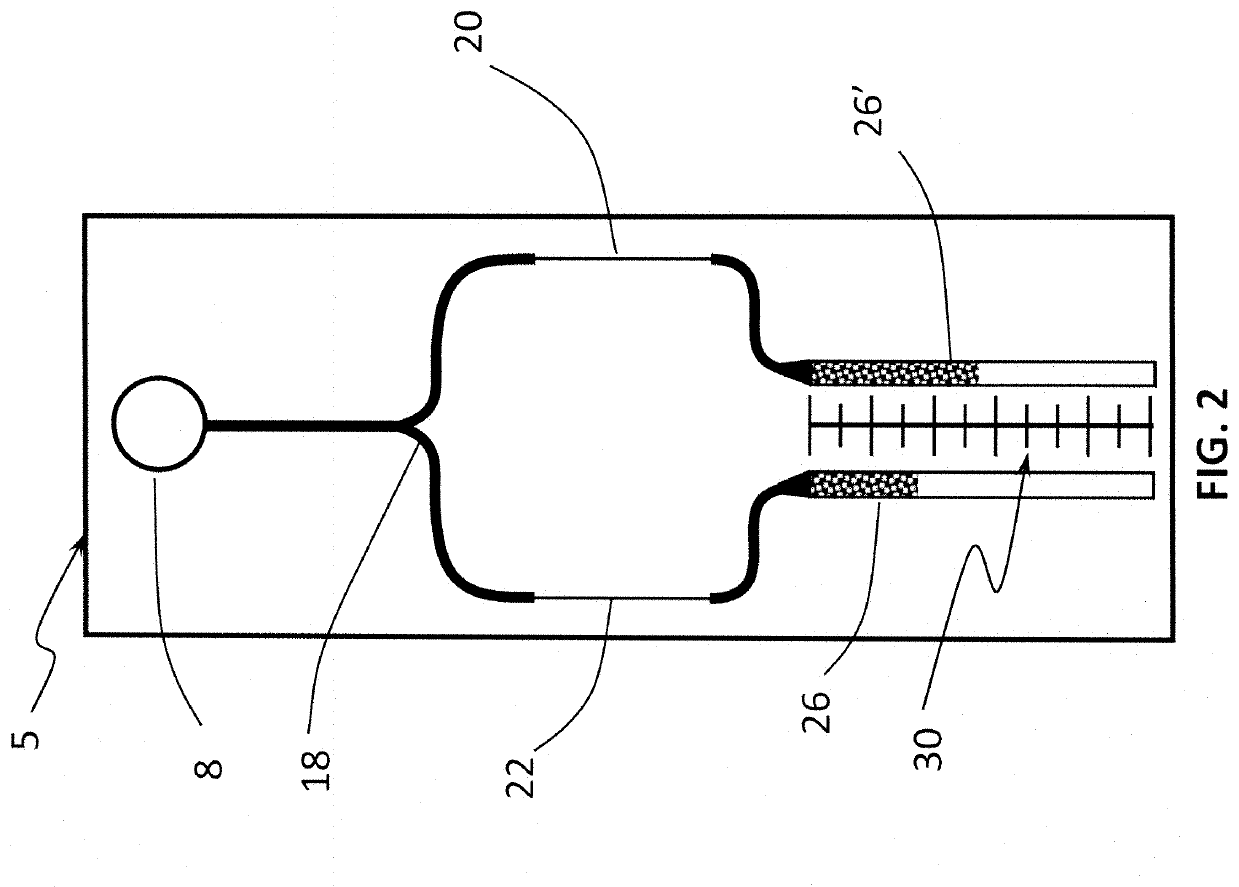Devices and Methods for Detection and Quantification of Immunological Proteins, Pathogenic and Microbial Agents and Cells
a technology of immunological proteins and microorganisms, applied in the field of immunoassays and microfluidic devices, can solve the problems of increasing the cost and complexity of assays, the manual counting of microbeads using microscopes, and the inability to detect and quantify immunological proteins, so as to reduce the cost and complexity, increase the sensitivity of lateral flow tests, and maintain the specificity and accuracy.
- Summary
- Abstract
- Description
- Claims
- Application Information
AI Technical Summary
Benefits of technology
Problems solved by technology
Method used
Image
Examples
example 1
c Basis and Technology Feasibility of the Present Invention
(A) Introduction
[0144]The data presented herein describe the effect that flocculation of magnetic-responsive micro-beads in a micro-channel has on the flow resistance of liquid in the micro-channel. A liquid seeded with magnetic-responsive micro-beads in a micro-channel that is exposed to a magnetic field gradient produces a localized micro-bead flocculation. This localized micro-bead flocculation results in a localized reduction of the cross section of the micro-channel, and thus in a localized increase of the flow resistance across the flocculation region. The increase in resistance, in turn, results in an increased pressure drop across the flocculation region due to the energy loss in maintaining the flow across the reduced cross-section of the micro-channel. If the external forces responsible for the formation of the micro-bead flocculation are stronger than the flow shear-stress on the micro-beads and their aggregates, ...
example 2
Prototype Fabrication and Testing
(A) Fabrication
[0151]Two sets of pScreen™ prototypes were fabricated: (1) a bench top prototype with multiple micro-channels for simultaneous testing of various samples; and (2) a single-use, portable, lab-on-card device. The pScreen™ bench-top prototype was described in the previous section. The pScreen™ lab-on-card prototype was realized using standard microfluidics fabrication techniques. In brief, the micro-channels were etched using a laser etcher system on a poly(ethylene terephthalate) glycol (Petg) substrate. The channels then were sealed using a matching poly(lactic-co-glycolic acid) (PLGA) top by thermal bonding using a hot press. The magnetic field gradient was obtained by placing two small magnets in an N-S configuration underneath the test channel. The pScreen™ lab-on-card prototype also was fabricated using injection cast molding in which the prototype was fabricated in poly(methyl methacrylate) (PMMA).
(B) Experimental Data for a Microf...
example 3
ationships between Flow Rate and Micro-Bead Concentration
[0155]The present invention provides a method of detecting and quantifying the concentration of magnetic-responsive micro-beads in a liquid sample, by calculating the ratio {tilde under (O)}m / {tilde under (O)}o, the difference {tilde under (O)}o−{tilde under (O)}m, and the ratio ({tilde under (O)}o−{tilde under (O)}m)p / ({tilde under (O)}m)q, wherein p and q are derived through a calibration process, wherein the ratios {tilde under (O)}m / {tilde under (O)}o and ({tilde under (O)}o−{tilde under (O)}m)p / ({tilde under (O)}m)q are a proxy for the number of magnetic-responsive micro-beads in the liquid sample, and then quantifying the concentration of magnetic-responsive micro-beads in the liquid sample.
[0156]Three methods are provided to show how to use these proxy relationships and how to derive in practice the number of magnetic-responsive micro-beads in a liquid sample. The first method analytically derives these relationships fr...
PUM
| Property | Measurement | Unit |
|---|---|---|
| concentration | aaaaa | aaaaa |
| concentration | aaaaa | aaaaa |
| concentration | aaaaa | aaaaa |
Abstract
Description
Claims
Application Information
 Login to View More
Login to View More - R&D
- Intellectual Property
- Life Sciences
- Materials
- Tech Scout
- Unparalleled Data Quality
- Higher Quality Content
- 60% Fewer Hallucinations
Browse by: Latest US Patents, China's latest patents, Technical Efficacy Thesaurus, Application Domain, Technology Topic, Popular Technical Reports.
© 2025 PatSnap. All rights reserved.Legal|Privacy policy|Modern Slavery Act Transparency Statement|Sitemap|About US| Contact US: help@patsnap.com



